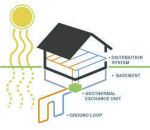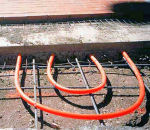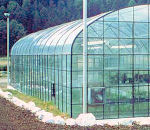
|
a |
|
- |
|
- |
|
- |
| careers |
|
||||||||||
|
municipal | industrial | marine & dredging | agriculture | sanitation | mining | electrical | irrigation | communications | residential | landfill | recreation | road & highway construction | geothermal heating | ventilation | hydronic | fireworks | fish farms | floating docks | culvert | pontoons | tile | material handling |
||
What is Geothermal Energy?
Geothermal comes from the Greek words geo, meaning
earth, and therme, meaning heat. Geothermal heat,
therefore, is literally earth heat. Often found in places
where geologic processes have allowed magma to rise up through the
crust as lava, or steam in a hot springs, people have sought to
harness this energy in some form or another over thousands of years.
With new technologies, from heat pumps, to sophisticated piping
materials and heat exchangers, geothermal energy has become more
than just a remote possibility. Unlike other kinds of geothermal
heat that are found in hot springs, volcanoes and other natural
hot spot formations, the heat in the ground is not dependent upon
tectonic plate activity or other unique geologic processes. Using
geothermal heat pumps and elaborate piping systems, heat can be
acquired anywhere in the world.
Archaeological evidence suggests that use of geothermal energy occurred more than 10,000 years ago in ancient Rome and with the settlement of the North American Indian at various hot springs. Just as these springs served as a source of warmth and healing, modern efforts are currently capable of probing more than 10 miles below the Earth's surface. Since 1807, when North American settlers first founded the city of Hot Springs in Arkansas, people have looked for ways to bring the heated water in a hot springs to their homes and places of business. It wasn't until 1892, however, that water is piped from a hot springs to buildings using modern technologies from heat exchangers to ground source heat pumps. With these technologies, geothermal energy is no longer restricted to just those areas near a natural hot springs, but can be derived from any water that is heated by the earth as it is transported through pipes buried below the ground.
 How
a Geothermal Energy System Works
How
a Geothermal Energy System Works
Geothermal energy uses the earth as a heat source as well as a heat
sink. Instead of creating heat like your furnace, a geothermal system
only moves heat from one place to another. Since earth heat hovers
around 55 °F (12.8 °C) at 10 feet (3 m) below the surface, it can
be used to heat buildings in climates warmer than 55 °F, or to cool
them in warmer climates.
In a typical system, you will find three major subsystems or parts: 1) a geothermal heat pump to move heat between the building and the fluid in the earth loop, 2) an earth loop piping system for transferring heat between its fluid and the earth, and 3) a distribution subsystem for delivering heating or cooling to the building.
 The
efficiency of a closed loop ground source heat pump is well known.
To extract the heat from the earth, a closed loop pipe or series
of closed loop pipes are connected to the inlet and outlet of a
heat exchanger and are buried in the ground. A heat exchange fluid
is circulated through this buried pipe system. If a difference exists
between the temperature of the fluid circulating in the pipe and
the earth temperature, a transfer of heat takes place. When the
system is in a heating mode, heat is taken from the fluid inside
of this circulating loop by a heat exchanger. As this cool water
is circulated back through the warm earth, heat is transferred into
the fluid, which is subsequently taken from this stream and used
to heat a building. Because of immense size, the earth remains at
a relatively constant temperature, providing a virtual limitless
resource as a heat supplier and heat sink.
The
efficiency of a closed loop ground source heat pump is well known.
To extract the heat from the earth, a closed loop pipe or series
of closed loop pipes are connected to the inlet and outlet of a
heat exchanger and are buried in the ground. A heat exchange fluid
is circulated through this buried pipe system. If a difference exists
between the temperature of the fluid circulating in the pipe and
the earth temperature, a transfer of heat takes place. When the
system is in a heating mode, heat is taken from the fluid inside
of this circulating loop by a heat exchanger. As this cool water
is circulated back through the warm earth, heat is transferred into
the fluid, which is subsequently taken from this stream and used
to heat a building. Because of immense size, the earth remains at
a relatively constant temperature, providing a virtual limitless
resource as a heat supplier and heat sink.
 Applications
of Geothermal Energy
Applications
of Geothermal Energy
Uses of geothermal energy range from localized heating and baths,
to large scale energy production. The heat pump has brought geothermal
energy into the home. These heat pumps don’t require extremely hot
reservoirs, or dry steam, but instead operate much like a refrigerator
with pipes extending either out or down in a loop below the frost
line. This technology can be used anywhere in the world, and is
available in your own backyard. This unlimited energy can be used
in both agriculture to extend the growing season, and aquaculture,
to shorten the time to grow fish and shrimp. Industrial uses include
process cooling, the pasteurization of milk and washing wool. In
some cases, local communities have even started using geothermal
energy to keep their sidewalks and roads from freezing. Some other
applications include:
- Hot Spring and Spa Bathing
- Greenhouse and Soil Warming
- Fish Farming
- Product Drying and Warming
- District Heating
Advantages of Geothermal Energy
The biggest advantage of a geothermal system is its ability to provide
a consistent and unlimited source of heat. While conventional heating
systems have to depend on outdoor temperatures that are constantly
in flux, underground temperatures remain relatively constant all
year round, producing the desired heating and cooling temperature
year round. Other benefits include:
- Renewable and Sustainable - is unlimited in supply and uses very little land to provide safe and clean energy.
- Comfortable - maintains an even temperature and humidity level throughout your home or place of business. Can heat or cool a building. Can also be used to heat or cool different parts of a building structure.
- Flexible - geothermal heat pump systems allow for design flexibility and can be installed in both new and retrofit situations.
- Aesthetic - geothermal systems are easy to conceal, don't require cooling towers, eliminate conventional rooftop equipment, less potential for leaks and ongoing maintenance, better roof warranties, allowing architects and building owners to plan for more aesthetically pleasing architectural designs and roof lines.
- Low Maintenance - since the workhorse of the system - the piping - is underground or underwater, there is little maintenance required.
- Durable - with no moving parts, and parts that are sheltered inside a building, a geothermal heating system is durable and highly reliable. Hdpe pipe has a life span expectancy of up to 50 years or more.
- Cheap - a geothermal system uses less electricity than conventional forced air heating or cooling systems. This means the less energy needed from burning fossil fuels that are harmful to the environment.
- Energy Efficient - reduces consumption of fossil fuels and enhances to the diversity of energy resources.
- Reduces Dependency - lowers importing and creates self-sufficiency in local economies.
Drawbacks
of Geothermal Energy
The biggest drawback is the initial cost of installation. While
geothermal heating is one of the most efficient ways to heat a building,
drilling holes for the pipiing is expensive. There is also the ongoing
costs of opeating the heat pump. Geothermal energy systems have
not been used in the past because it is expensive to design and
install the pipe loop heat exchanger which must be buried in the
ground. Many of the complex geological and installation parameters
that set the rate of heat transfer between this buried heat exchanger
and the earth, also determine the performance and efficiency of
the system. The uncertainty of the installation costs, combined
with the uncertainty of the resulting operating efficiencies make
it hard for the customer to predict the operating costs and the
return on investment.
Contact
us today by email or our toll free number:
sales@oxfordplasticsinc.com
1.800.263.0502
|
Copyright ® 2003 - 2008 | Oxford Plastics Inc. | All Rights Reserved |
|||
|
Oxford Plastics Inc. ~ PO Box 119, Oxford Road 6, Embro, Ontario, CANADA, N0J 1J0 |
|||
|
Office: 519.423.6232 ~ Fax: 519.423.6057 ~ Toll Free: 1.800.263.0502 |
 Geothermal Energy
Geothermal Energy